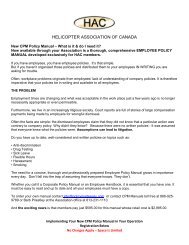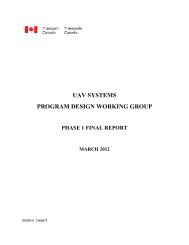HAC Oil & Gas IBP - Helicopter Association of Canada
HAC Oil & Gas IBP - Helicopter Association of Canada
HAC Oil & Gas IBP - Helicopter Association of Canada
Create successful ePaper yourself
Turn your PDF publications into a flip-book with our unique Google optimized e-Paper software.
3.3. Minimum Staffing3.3.1 Flight crew3.3.1.1 Number <strong>of</strong> Flight crew present and available on the operations should allow performance <strong>of</strong> therequired operations without exceeding the maximum flying periods stipulated for the FlightCrews in section 9.2.3.3.1.2 Single/two pilot factors.For passenger carrying flights in high workload environments, two pilot operations are acceptedbest practice. For operations carrying more than 9 passenger’s two pilots are alsorecommended as per (FAR 27/FAR 29 Amendment 44). However, due to considerations <strong>of</strong>payload, aircraft performance and pilot resources, proximity to the ground and associated timeconstraints when conducting vertical reference operations; the use <strong>of</strong> a single pilot may beproposed subject to a satisfactory risk assessment. Factors taken into account when assessingthe risk <strong>of</strong> using a single pilot includes the following bullets and should be considered as theacceptable requirements when completing the risk assessment:• <strong>Helicopter</strong> typeooCertified for single pilot in country <strong>of</strong> use.Equipped for single pilot long line and vertical reference operations with remotegauges, load meters, master caution, mirrors, bubble windows or floor windows.• Remote flight following (AFF Satellite systems preferred)• Pilot trainingooooo• Flight environmentooooSimulator or FTD training at a preferred frequency 12 months and not more than24 months, when available for the aircraft type, completed as a single pilot,covering all emergencies for the type being flown, including tail rotor failure,engine failure, governor failures etc.Annual operational long line/ vertical reference training completed.Annual line check completed in addition to annual check flight.Airborne Decision Making course completed within 2 years by qualified provideror facilitator.Annual Inadvertent IMC training and competency test completed.Planned and conducted in day, VFR only.Uncongested airspace – likelihood <strong>of</strong> air collision minimal, including other aircrafton same task. Radio procedures in place for airspace separation.Navigation complexity versus navigation equipment in use.Types and size <strong>of</strong> landing areas suitable for single pilot crew. No additionallookout required.• Type <strong>of</strong> flight. Long transits, particularly those including a point <strong>of</strong> no return and/or in remotehostile areas (e.g. arctic) should have 2 pilots.• Fatigue Managemento Single pilot flight duty hours applied without extension (See section 9.2)oSatisfactory environmental factors (extreme heat or cold effectively mitigated).Failure to meet all <strong>of</strong> the factors listed above should result in a two pilot crew or additionalmitigation factors being applied.OGC <strong>IBP</strong> | Revision Date: Sept 2009 DRAFT11









